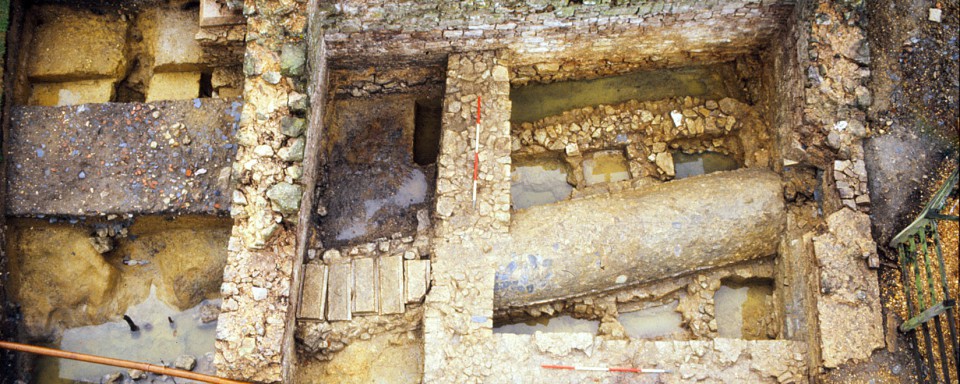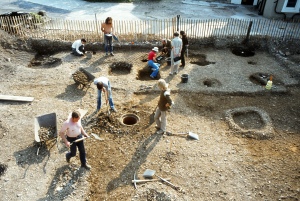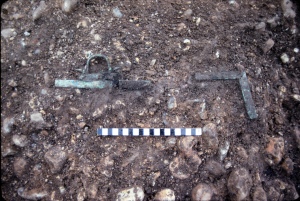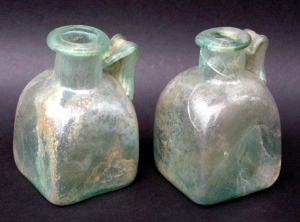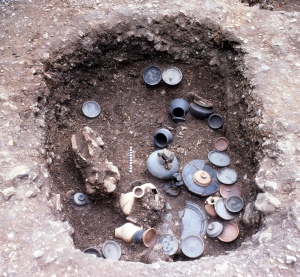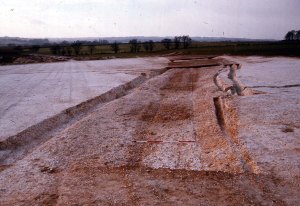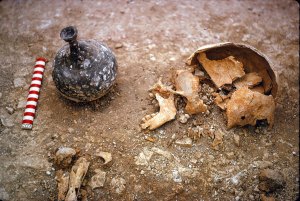Home » Posts tagged 'Romano-British' (Page 2)
Tag Archives: Romano-British
Buried in time – an Early Romano-British cemetery at Alton
A small Early Romano-British cremation cemetery was excavated at 87 High Street, Alton in 1860 and again in 1980. The first excavation uncovered a richly furnished cremation burial and most of the finds ended up in the Curtis Museum in the town. In 1980, before the construction of the Inner Ring Road, further exploration took place and eight more graves were excavated. All of the graves contained a large assemblage of pots as grave goods and several contained other items as well. The pottery suggests a date in the 1st century AD.
The richest burial, known as Grave 2, was a shallow pit first discovered in 1860 and only completely excavated in 1980. The earlier excavation found 18 pottery vessels, two glass vessels, 19 glass gaming pieces and a gold signet ring. Metal corners were noted surrounding the gaming pieces and the presence of the ring suggested that these were originally contained within a wooden casket, along with the cremated remains of the deceased.
The 1980 excavation added a further 13 pottery vessels to the contents of this grave, as well as four copper alloy corner plates and a drop handle (which probably represent the remains of a gaming board). In addition there were two spoons, a fragment of an iron knife blade and a glass bead. The cremated bone is from an adult of indeterminate sex, although the signet ring and gaming pieces suggest he was male.
The stone inset in the gold signet-ring was engraved with four symbols representing Roman deities. At the time of the burial, Roman law dictated that gold rings could only be used by people of high rank, indicating that the deceased was of high status, possibly a native aristocrat. A signet-ring was generally passed to the heir at the time of death as proof of succession and it is unusual for one to be found in a grave. The most likely explanation for the inclusion of the ring is that the deceased was young, or without heirs.
Another of the Alton graves, known as Grave 5, was in a deep pit with two distinct deposits. The upper layers contained 13 broken pottery vessels, a scatter of animal bone and cremated human bone. The lower deposit had been carefully covered with earth and levelled before this upper material was added. The lower deposit itself contained 40 pottery vessels, two brooches, two finger rings of copper alloy and iron, a copper alloy cosmetic set (tweezers, nail-cleaner, ear scoop), copper alloy fragments of a casket (including studs, lock plate and drop handle), an iron knife and eight nail fixings from a wooden box. The grave also contained an inverted horse skull. Cremated bones from an adult of indeterminate sex were contained in a pot with a lid placed in the grave early in the sequence of filling. The grave goods suggest that this may be a female burial. The broken pottery in the upper fill of the grave may represent the disposal of things used to prepare a funerary feast after the remainder of the grave had been filled.
A1980.80
Further reading
Millett M (1986) Early Roman Cemetery at Alton, Hants Field Club Vol 42, pp 43-87
Series by Dave Allen, Sarah Gould, Lesley Johnson, Jane King, with help from Stacie Elliot.
Buried in time – eight Romano-Britons (Burntwood Farm)
This site, to the west of Burntwood Farm, was excavated in the 1970s as part of the M3 (motorway archaeology) project. It lies 4 km north-east of Winchester, overlooking a bend of the River Itchen. A small isolated cemetery was found, consisting of eight large graves of Romano-British date. Seven of the graves lay head-to-toe alongside a shallow boundary ditch which ran in a north easterly direction towards a Roman road; an eighth grave lay some 40m away by the junction of the ditch and road. The road was heavily rutted and repaired with flint nodules. Pottery analysis indicates that it was probably in use during most of the Roman period, running parallel with, and to the east of, the Winchester-Silchester Roman road (now the A33) and cutting across prehistoric field systems.
Five females, two males and a child had been buried in oak coffins, all except one with their heads at the western end of the grave. The grave at the road-ditch junction contained a female, aged 25-40. This skeleton was lying on its side, with its legs crossed above the knees and the arms crossed above the wrists. At least two of the 40 or more coffin nails had impressions of oak. Around 90 iron studs and nails from the shoes with which she was buried were also recovered. Given the number of shoe nails found in this and another of the female burials, the design of the shoe soles was probably more complex than a simple three-row pattern.
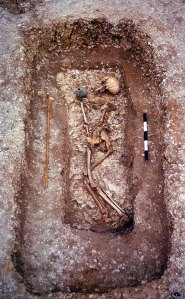
Coffin burial of a female aged 25-35. The New Forest jug (near the skull) was probably placed on the coffin lid.
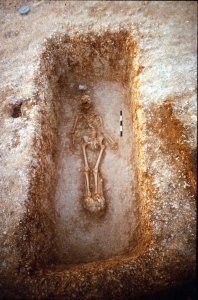
Male burial (30-40) in a coffin represented by 100 nails and fragments of oak and birch. A New Forest beaker was placed near the head.
Oak was a component in the construction of all eight coffins; five of the burials included grave goods which indicated a 4th century date. A single pot was found with four of the inumations, and the child burial (an infant of 2.5 – 3 years) was accompanied by a narrow-spouted New Forest Fine Ware flask and a Black Burnished flanged pie-dish of 4th century form. Two other graves contained examples of New Forest Fine Ware. Another inhumation burial, probably of an adult female, included a globular–bodied flask with a broken neck, possibly orange Oxidised Ware from the Oxfordshire kilns.
The linear arrangement of seven of the burials along a land boundary ditch is unusual, and may have been intended as the first stage of an ordered cemetery which was never taken any further.
A1978.17 – M3 site R6
Further reading: Fasham, P (1980) Hampshire Studies, 36, pp 37-86
Series by Dave Allen, Sarah Gould, Lesley Johnson, Jane King, with help from Stacie Elliot.
